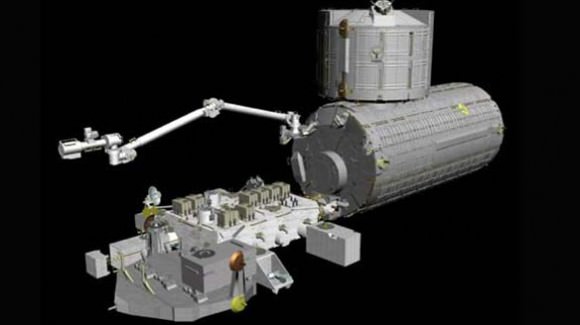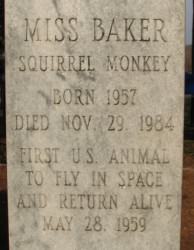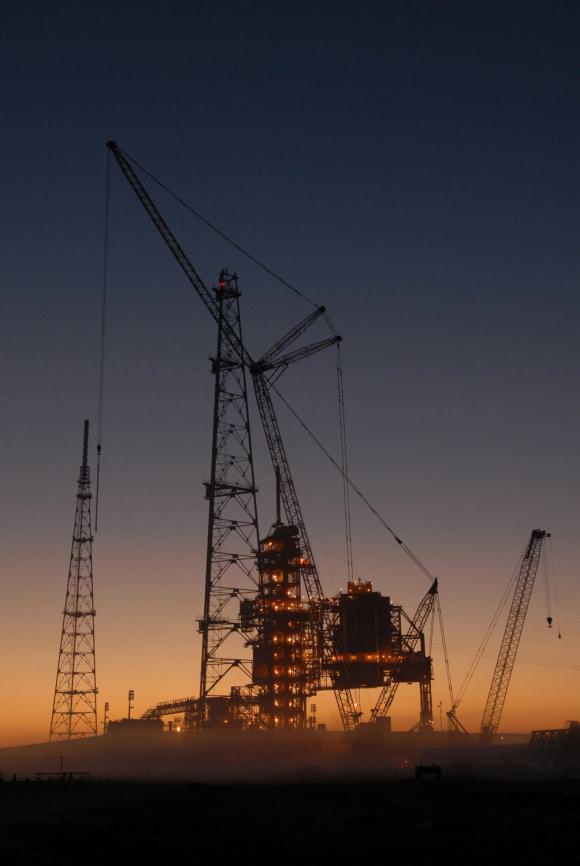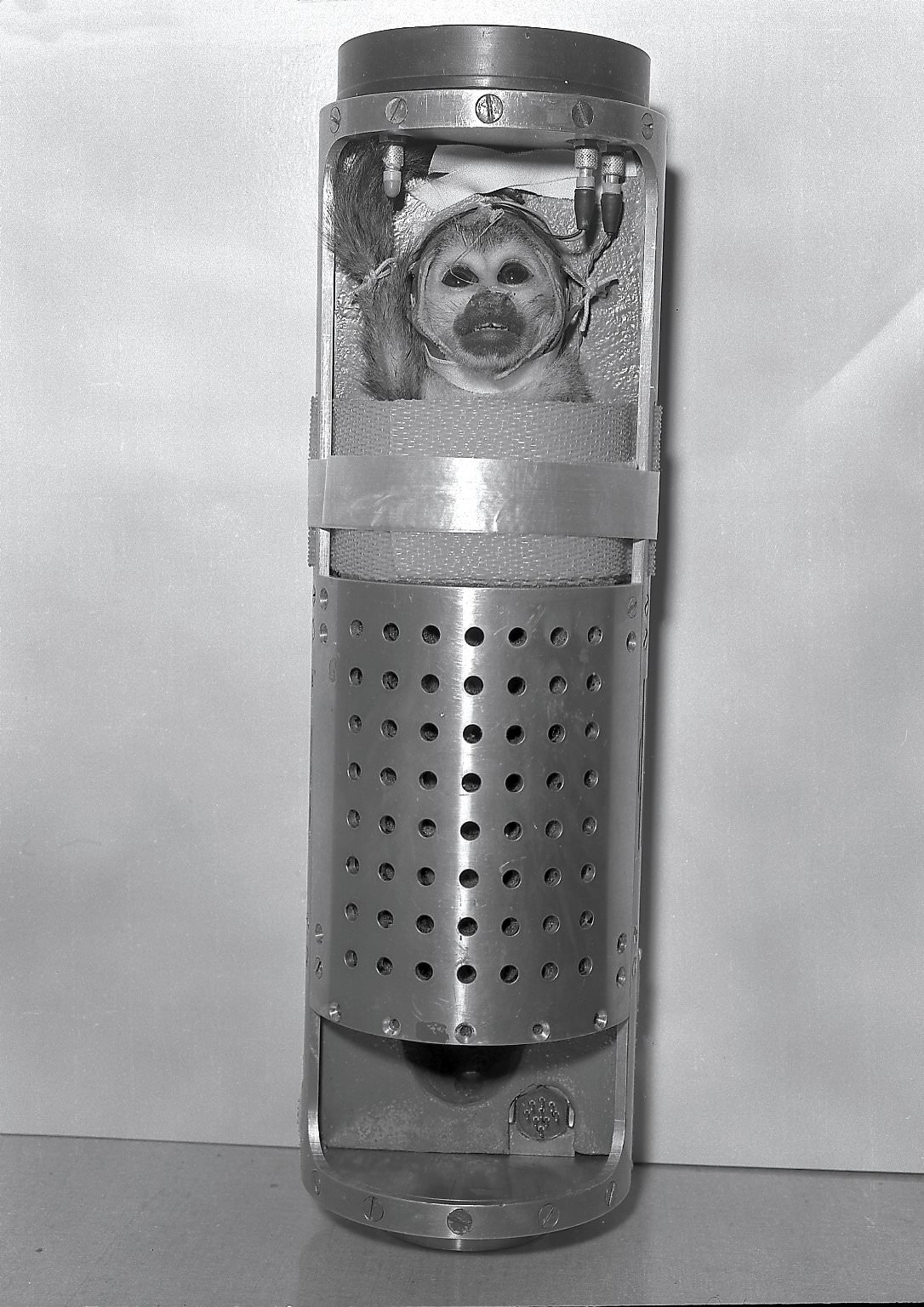It’s a crowded dance floor and someone had to step aside. Because of Saturday’s launch delay for STS-127, the shuttle and the upcoming dual mission to the moon — the Lunar Reconnaissance Orbiter (LRO) and Crater Observation and Sensing Satellite (LCROSS) — were both vying to launch from Kennedy Space Center on the same day, which is not a possibility (usually there needs to be at least 48 hours between launches as the Air Force’s Eastern Range that monitors needs that amount of time to reconfigure the systems.) At a press conference today, NASA launch manager at KSC, Chuck Dovale announced LRO/LRCROSS will give up their originally schedule launch date of June 17 so that the shuttle can go. “We are relinquishing the June 17 date to the shuttle,” he said. “However, we will maintain June 18 as the earliest possible date for LRO/LCROSS. We will monitor the shuttle’s progress, and if they were to scrub the launch for any reason before midnight on the 16th, we can still maintain launch on the 18th.” But there’s a lot that has to go right for the optimum and hoped for launch schedules to happen.
Continue reading “LRO/LCROSS Gives Up Launch Date for STS-127”
What Happens During a Last Second Shuttle Launch Abort
Holy Moly! Not to wish anything like this for Saturday’s launch, but I came across this video of the STS-68 launch attempt in 1994 that was aborted at the very last second. Watching it is enough to make your heart stop. Everyone involved must have experienced a tremendous rush followed by extreme let-down! The main engines had lit, but were shut down 1.9 seconds before liftoff when on-board computers detected higher than acceptable readings in a sensor monitoring the discharge temperature of the high pressure oxidizer turbopump in main engine #3. In the history of the shuttle program, five launch attempts were aborted under five seconds from the planned launch. STS-68 came the closest to hauling the mail before being aborted.
Continue reading “What Happens During a Last Second Shuttle Launch Abort”
Company’s Coming! And They’re Bringing the Front Porch
[/caption]
UPDATE: 6/13
Endeavour’s launch has been postponed because of a leak associated with the gaseous hydrogen venting system outside the shuttle’s external fuel tank. The system is used to carry excess hydrogen safely away from the launch pad. Managers scrubbed the launch for at least 96 hours. The earliest the shuttle could be ready to launch is June 17. However, there is a conflict on the Eastern Range that date with the scheduled
launch of the Lunar Reconnaissance Orbiter/Lunar Crater Observation and Sensing Satellite. We’ll keep you posted on when a launch date is set.
Original article:
Space shuttle Endeavour is all set to blast off Saturday morning, June 13 at 7:17 am EDT, heading to the International Space Station. The mission will be jam-packed with five spacewalks for station construction, and Endeavour is bringing up a “front porch” for the ISS. Is adding a porch an attempt to make our orbiting home in space just a little more “homey?” Actually, the porch is a key piece of the Japanese laboratory, Kibo. And the ISS itself will be jam-packed, too as the newly expanded six-member ISS crew will welcome the seven-member shuttle crew – a record number of astronauts to be on board the station at one time.
On Friday morning the Rotating Service Structure was removed from around Endeavour, and all indications are good for an on-time liftoff Saturday. The weather looks to be about 90% “go,” and the shuttle processing has been smooth in preparations for launch.
“We’re in really good shape to fly,” said Mike Moses, director of shuttle integration at the Kennedy Space Center. “The team carefully reviewed the spacecraft to make sure nothing was overlooked since the launch comes only a few weeks after the end of the STS-125 Hubble repair mission.
Moses said having the big crew on the station could be an interesting time. “It’s like having your family descend on you for the holidays, right? And they’re going to stay for a very long time. And they come, and they’re bringing all their stuff.”
But he said the combined crews are more than ready for the challenge. “I think what we’re going to see is probably some unprecedented efficiencies because they all know where to go, they know what the procedures are, they know how to get things done,” he said.

Endeavour’s crew will install the porch, which is actually a platform for one end of the Kibo laboratory on the station. The platform will hold experiments designed to work outside the protective confines of the station, exposing them to the space environment.
Mark Polansky (follow him on Twitter at Astro_127) will command the shuttle for STS-127. Douglas Hurley will serve as the pilot. Mission specialists are Christopher Cassidy, Thomas Marshburn, David Wolf and Julie Payette, a Canadian Space Agency astronaut.
Also flying along is Timothy Kopra, who will stay on at the ISS as a flight engineer and science officer, while current ISS resident and Japanese astronaut Koichi Wakata will return to Earth.
This will be a banner flight for all the international partners, as all five space agencies – the United States, the Russian, the Canadian, the Japanese and the European – will have representatives at the space station when the shuttle arrives, in addition to the six extra Americans and one extra Canadian Endeavour will carry. Polansky said just having all those nations represented and working together toward common goals is a huge accomplishment.
“I don’t think that, as a global community, we get the credit we should for doing something like that and what it means to set that kind of example,” he said. “Countries that have, historically, had a lot of differences and even today have some tensions, politically – when it comes to the arena of space, we’re somehow insulated from all that. On our level, it’s simply figuring out how to get the job done. And it’s not just a job like you’re constructing some building here on Earth. You’re doing something in an extremely hostile environment.”
The two crews will be extremely busy during the 16 day mission, so don’t expect to see them sitting back and relax on the front porch.
If you want to watch the launch preparations on NASA TV, the crew will strap into Endeavour about 4:00 am EDT on Saturday.
NASA’s Shuttle Program Hands Over Launch Pad to Constellation
[/caption]
It’s the end of an era, as Launch Pad 39B at Kennedy Space Center has been officially handed over to the Constellation Program. The handover took place Sunday after space shuttle Endeavour was moved to Launch Pad 39A. The ground operations team will finish modifying pad B for in time for first flight test of the Ares I-X rocket, currently scheduled for around August 30 of this year. Modifications will include removing the orbiter access arm and a section of the gaseous oxygen vent arm and installing access platforms and a vehicle stabilization system.
Since the late 1960s, pad B has been instrumental in human spaceflight programs. Originally, the pad was built for the Saturn V rockets for the Apollo flights to the moon, as well as flights to launch the Skylab space station and to send three crews to live on board. It also saw the launch of the Apollo spacecraft that was part of the Apollo Soyuz test program, where spacecraft from the US and USSR docked in space. In the 1980’s the pad was refitted for the space shuttle. Pad 39B was not ready until 1986, and the first Shuttle launch to use it was the ill-fated STS 51-L flight – the Challenger Disaster.
But now it’s time for the next generation of spacecraft and launch system. The Constellation Program is developing the Ares I and Ares V launch vehicles, the Orion crew capsule, and the Altair lunar lander — to carry humans to the International Space Station, the moon and beyond.
The Truth About NASA’s UFO Videos
Perusing You Tube, there are lots of UFO videos, which are usually grainy, shaky videos showing nothing that can be proved definitively. But there are a couple of videos that are different — and have generated a lot of interest — because they were filmed by NASA astronauts during space missions.
I’d like to recommend everyone read an article published today by Popular Mechanics where the astronauts who were behind the camera for two of these videos speak out about what is actually in the videos, and NASA’s supposed “cover-up.” The two astronauts, Tom Jones and Mario Runco “reveal” what the videos are really showing.
“There’s no way to keep people from using public domain footage for silly purposes,” former astronaut Tom Jones says in the article. “If a shuttle beams back 10 hours of Earth views each day, there are bound to be images and scenes that are misunderstood or taken out of context.”
And “out of context” is what many UFO theories and proponents rely on, says writer Erik Sofge. And NASA tends to never make official statements debunking any of the UFO claims, which helps fuel the flames. One clip, taken by Runco is of the PAM-STU satellite that Runco and his crew deployed during the STS-77 mission in 1996, outfitted with reflective materials. During the entire clip, however, Runco or mission control never says exactly what they are filming, but keep referring to it as “the target,” typical for pilots and NASA astronauts. There are other oddities about the clip, with lights moving in the background, but Runco says the lights are likely to be stars.
Another clip, taken by Jones is simply “ice crystals or flakes of thruster residue in the near field are floating by, get hit by a thruster exhaust plume and zip out of the scene,” Jones said.
It’s one thing to believe that alien life is a statistical likelihood, and quite another to interpret lights in the sky as intergalactic contact. Check out the great article, and kudos to Jones and Runco for speaking out.
Spaceships on the Move!
[/caption]
Atlantis has begun her journey back home to the Kennedy Space Center, hitching a ride on the Shuttle Carrier Aircraft, a modified Boeing 747. The flight took off at about 11:05 EDT on Monday morning from Edwards Air Force Base, and the duo will fly to Biggs Army Air Field in El Paso, Texas and spend the night there before resuming the cross-country trip on Tuesday. Of course, Atlantis just returned from space, landing at Edwards on May 24, concluding the STS-125 mission to service the Hubble Space Telescope for the last time. Track the flight here.
But Atlantis isn’t the only spacecraft on the move. The shuttle Endeavour just rolled around to launchpad 39A, after standing down from its potential rescue mission, (STS-400) in case Atlantis was unable to return home, and now is preparing for the STS-127, which will hopefully launch around June 13. Watch the video of the rollaround below. And the next missions to the Moon are now poised for launch.
On May 28, the Lunar Reconnaissaince Orbiter and the Lunar Crater Observation and Sensing Satellitespacecraft were transported to the launch pad. The transport of the stacked and encapsulated LRO/LCROSS payload began at about 2 am local time and culminated with the attachment of the payload atop the Atlas AV-20 rocket at about 9:30am.

The spacecraft will launch together June 17 from Cape Canaveral Air Force Station in Florida.
Using a suite of seven instruments, LRO will help identify safe landing sites for future human explorers, locate potential resources, characterize the radiation environment and test new technology. LCROSS will seek a definitive answer about the presence of water ice at the lunar poles. LCROSS will use the spent second stage Atlas Centaur rocket in an unprecedented way that will culminate with two spectacular impacts on the moon’s surface.
50th Anniversary of Historic Space Monkey Flight
[/caption]
The image to the left is not a primate astronaut from “Planet of the Apes.” It is, in fact, a real space monkey. Today marks the 50th anniversary of the first flight into space of a living being that survived the expedition. On May 28th, 1959, one rhesus monkey, named Able, and one squirrel monkey named Miss Baker became the first “astronauts” to survive a return flight into space.
Though they were not the first animals launched into space, Able and Baker helped pave the way for human spaceflight by showing that animals can indeed survive the rigorous launch and return of a spacecraft. Their vital signs were monitored during the mission, giving scientists a better understanding of what stresses spaceflight puts on a living body.
Launched aboard a Jupiter AM-18 rocket, Able and Baker flew to a height of 360 miles and traveled 1700 miles from their launch site at the Eastern Space Missile Center at Cape Canaveral, Florida. Their capsule landed in the ocean, and was retrieved by a U.S. Navy vessel commanded by Joseph Guion.
Guion told NASA, “As soon as I picked it up out of the water, it was flying all over the place. The ship was rolling and the nose cone swung back and forth. And I was just hoping that nobody would get hurt…We still didn’t know if the monkeys were alive ‘cause we didn’t have the telemetry. And so one technician ran up to the back end of it and plugged in and he says, ‘They’re alive!’ So everybody went ‘Yay!’ And that’s when I could finally say, ‘Ah!’ Relax.”
The entire flight lasted about 15 minutes, and during nine minutes of that the two tiny astronauts experienced weightlessness. After the recovery of their capsule, the monkeys were allowed to relax in an air-conditioned room aboard the vessel, then escorted to Washington, D.C. for a press conference.
To see a video of Able and Miss Baker getting ready for flight, check out this video on Youtube: Able and Baker blast off, from Universal News 1959.
Able died, unfortunately, a few short days after the flight. She needed an operation to remove an infected medical electrode, and had an adverse reaction to the anesthetic. Miss Baker, however, survived another 25 years, living at the U.S. Space and Rocket Center in Huntsville, Ala. During the rest of her life, she would receive over 100 letters a day from children who read about her adventures in textbooks and wanted to say ‘Hello’.
Miss Baker’s contribution was far from forgotten at the time of her death, and at her funeral in 1984 the attendance was well over 300 people. She still has a grave marker (pictured below) in front of the Alabama Rocket Center memorializing her part in the history of spaceflight.

Able and Baker were preceded by a long line of unsuccessful attempts by the U.S. to launch primates into space. The first attempt was Albert, who flew to 39 miles (63km) on June 11, 1948 aboard a V2 rocket, but died of suffocation during the flight. Albert II actually made it into space (above 62 miles/100km) on June 14th, 1949, but died upon the impact of his re-entry flight.
Primates were far from the first living things sent intentionally into space. That distinction belongs to a member of a different part of the animal kingdom: fruit flies. Fruit flies were sent into space, along with a sample of corn seeds, in 1947 to test the effects of radiation at high altitude.
So, to celebrate this historic event in spaceflight, it may be fitting to eat a banana for breakfast (or lunch, or dinner, or all three).
Should July 20 Be a US National Holiday?
[/caption]
I came across a new website, and it has an interesting purpose: the website proposes to create a Space Exploration Day national holiday in the US, and fittingly, suggests July 20 as the date. July 20, of course, is the date that the Apollo 11 mission landed on the Moon, and this year we celebrate the 40th anniversary of that historic mission.
The official website for the Space Exploration Day invites US citizens to sign a petition to create this new holiday, which they suggest could be on the order of Flag Day. Additionally, the website advocates July 16 – 24 be designated as a period of U.S. Space Observance, in commemoration of the nine day Apollo 11 Mission.
From the website:
“Whereas on July 20, 1969, the people of the world were brought closer together by the first manned exploration of the Moon; …”
“Whereas in this same spirit of greatness that made possible, the placing of astronauts on the Moon can be applied to all noble pursuits, including peace, brotherhood, advancement of the human spirit, and the exploration of new frontiers for the benefit of all mankind… ”
I think it is a great idea.
Read the rest on the Space Exploration Day official website, and if you think it’s a good idea, too, sign the petition.
Bolden Nominated as NASA Administrator; Shuttle Landing Delayed
[/caption]
About the same time space shuttle Atlantis’ landing was waved off today due to continued rainy weather in Florida, the White House announced that former shuttle commander Charles Bolden Jr. will be nominated as NASA’s next administrator. President Obama also chose Lori Garver to be Bolden’s deputy administrator. Obama said, “These talented individuals will help put NASA on course to boldly push the boundaries of science, aeronautics and exploration in the 21st century and ensure the long-term vibrancy of America’s space program.”
Several different sources expect Bolden to be a strong proponent of manned spaceflight, since he has flown on the shuttle four times, with over 680 hours in space. Many believe he will also be strongly in favor of the Constellation program, as well as support the efforts of some members of Congress who would like to see the life of the space shuttle extended beyond 2010.
Bolden and Garver will have to be approved by Congress, which can sometimes be a lengty process. Let’s hope not – over four months without an official administrator is long enough.
Bolden will have his work cut out for him, as NASA has a lot on its plate, but no real growth in its budget. The fiscal year 2010 budget request of $18.686 billion includes $456M increase for science and $630M increase for Exploration. Some of that increase is because of the one-time Recovery Act stimulus money. Future budget proposals for fiscal years 2011, 2012, 2013 also are also relatively flat. NASA Watch.com reported several sources say Bolden expressed concern at his meeting with President Obama because he was told that further cuts to human spaceflight in future budgets might be needed.

Meanwhile, the crew of STS-125 will stay on orbit another day. NASA officials are still hoping the shuttle can land at Kennedy Space Center in Florida rather than Edwards Air Force Base in California.
The astronauts will have two opportunities to land in Florida Sunday and two at Edwards. The first Florida opportunity, the astronauts would fire Atlantis’ twin braking rockets at 8:58 am EDT with landing at 10:11 am. A second Florida landing opportunity is available at 11:49 am.
Friday’s landing attempt was also canceled because of rain, low clouds and lightning. The forecast for Sunday is marginal, with clouds and rain expected, but flight controllers are hopeful conditions will improve.
More Stunning Images From the Hubble Servicing Mission

In our last installment of images from the STS-125 mission, we left off with third EVA of the mission. Since then, as I’m sure you know, the astronauts have completed two more EVAs, released Hubble and are waiting for the weather to improve in Florida so they can land. So, let’s get caught up with the latest images released by NASA. I love the image above, as it has everything in it about the mission: two spacewalking astronauts from EVA #4 (Mike Massimino and Mike Good), the shuttle Atlantis, Hubble, and a beautiful view of Earth.
Continue reading “More Stunning Images From the Hubble Servicing Mission”







